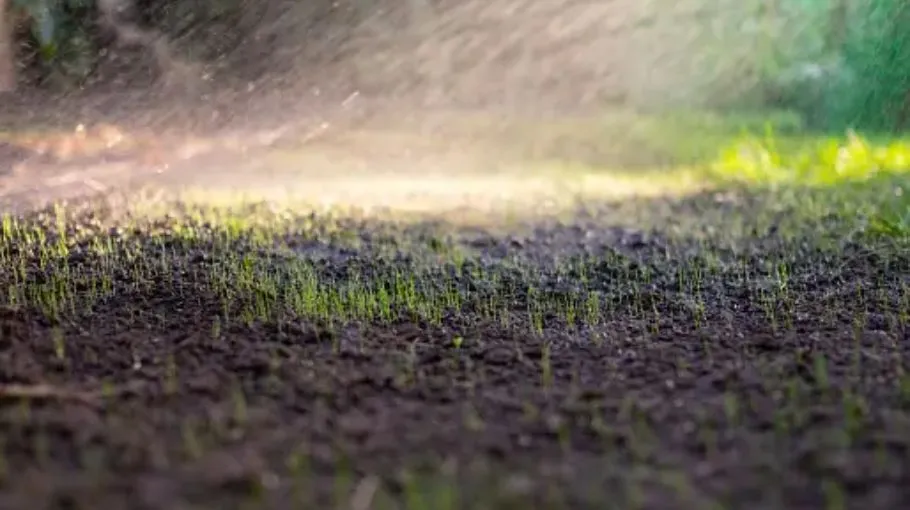The Importance of Water in Grass Seed Germination
Water is a vital component in the germination process of grass seeds. Here’s how it works:
- Seed Activation: Grass seeds absorb water, which triggers metabolic processes that lead to germination. Without sufficient moisture, seeds may remain dormant.
- Nutrient Uptake: Water facilitates the absorption of essential nutrients from the soil, promoting healthy growth.
- Root Establishment: Adequate moisture encourages deep root development, which is essential for drought resistance and overall lawn health.
Without the right amount of water, your new grass seeds may struggle to germinate, leading to patchy or weak growth.
Initial Watering: Setting the Stage
The first watering after planting your grass seed is crucial:
- Thorough Soaking: After sowing the seeds, water the area thoroughly. Ensure that the top 2 to 4 inches of soil is evenly moist. This initial soaking helps the seeds settle in and absorb water.
- Daily Watering: For the first week, aim to water the area daily. Light and frequent watering keeps the soil consistently moist, which is essential for germination.
Creating a Watering Schedule
As your grass seed begins to germinate, you can adjust your watering routine based on the seed’s development:
Weeks 1-2: Consistent Daily Watering
During the first two weeks, it’s vital to keep the soil consistently moist. Watering should occur daily, ideally in the morning. A duration of 5 to 10 minutes per session is generally sufficient.
Weeks 3-4: Transition to Every Other Day
Once you see grass blades emerging, you can shift to watering every other day. This allows the seedlings to establish while still ensuring they receive adequate moisture.
Week 5 and Beyond: Deep Watering Techniques
After about four weeks, your grass should be well-established. Transition to deep watering sessions every 3 to 4 days. Aim to water for 20 to 30 minutes, allowing moisture to penetrate deeply into the soil. This encourages stronger root growth and prepares your lawn for dry spells.

Factors That Influence Watering Frequency
Several variables can impact how often you should water new grass seed:how often to water new grass seed
- Soil Type: Sandy soils drain quickly and may require more frequent watering, while clay soils retain moisture longer.
- Weather Conditions: Hot, dry, or windy weather can lead to increased evaporation, necessitating more frequent watering. Conversely, cooler and more humid days may allow for less watering.
- Grass Type: Different grass varieties have different moisture needs, so it’s important to research the specific type of grass seed you are using.
Recognizing Underwatering and Overwatering
Understanding the signs of both underwatering and overwatering is essential for maintaining healthy grass:
Signs of Underwatering
- Delayed Germination: If seeds take longer than expected to sprout, they may not be getting enough moisture.
- Weak Growth: Grass appears thin, sparse, or unhealthy.
- Dry Soil: The soil feels dry and cracks when checked.
Signs of Overwatering
- Seed Rot: Excess moisture can lead to seed rot, preventing germination.
- Soggy Soil: Soil appears muddy or waterlogged.
- Fungal Growth: The presence of mold or mildew indicates that the grass is getting too much water.
Tips for Effective Watering
To ensure that your new grass seed thrives, follow these practical tips:
- Use a Sprinkler or Soaker Hose: These tools help distribute water evenly and minimize evaporation, ensuring all areas receive moisture.
- Water Early in the Morning: Morning is the best time to water, as it allows grass to absorb moisture before the heat of the day and reduces evaporation losses.
- Check Soil Moisture Regularly: Use your finger to check the moisture level of the soil. If it feels dry a couple of inches down, it’s time to water.
- Avoid Watering Late in the Evening: Watering at night can leave grass wet overnight, increasing the risk of fungal diseases.
Conclusion
Understanding how often to water new grass seed is vital for establishing a lush, healthy lawn. By following the guidelines outlined in this article, you can create an effective watering routine that supports germination and growth.
For more expert tips on lawn care and maintenance, visit perfectgreenyard.com. With the right approach to watering, your new grass will flourish, turning your yard into the perfect green space you’ve always desired!